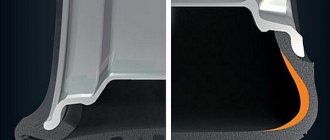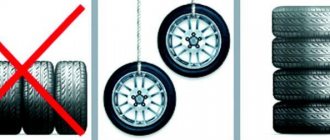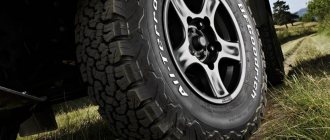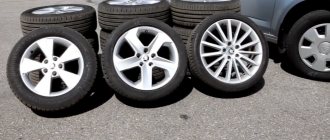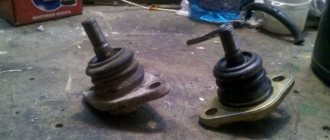Are you looking for how to properly install asymmetrical outside and inside tires? In the article you will learn what outside and inside tires are - everything about asymmetric tires. How to properly install inside outside tires on a car.
Asymmetrical tire tread – inside, outside (or Side Facing Out and Side Facing Inwards)
There are 3 types of tire tread patterns: symmetrical, asymmetrical and directional
The asymmetrical tread type came to us from motorsport. And it remains the most effective at high speeds, especially in corners; it is the asymmetry that improves the quality of car control. Asymmetric tires are becoming increasingly popular on the market these days because... have a number of advantages over other types of tires.
The asymmetric tread of the tire divides it into two parts, one of them will be external, the second external, usually they differ in the pattern and arrangement of the blocks. To understand which side of the tire is the outer side and which is the outer side, marks (inscriptions) are applied on the sidewall - inside and outside.
Inside (in) – denotes the inner side;
Outside (out) – external.
Installation in compliance with the sides of the tire is very important, because The correct operation of the tire and its functionality depend on this. In order for a car with asymmetrical tires to behave correctly on the road, the tires must be installed in accordance with the marks: outside - outward, inside - inward. For example, the outer part of the tire may have a rib that strengthens the tread blocks and helps maintain its shape during various maneuvers at speed. Those. The blocks are connected on the outside by a stiffening rib, but not on the inside. Labels Left or Right - means that the tires of this model are left and right. When installing them, you must strictly follow the rule for installing tires on a car: left ones only on the left, and right ones only on the right. Correct installation affects:
- Controllability
- Durability
- Braking properties
- Noise level
- Resistance to hydroplaning and much more
Be sure, after you have installed asymmetric tires on your car, check that they are installed correctly. If you see the inscription OUTSIDE on all tires (on the sidewalls) when walking around the car, then everything is installed correctly.
Correct tire installation and no outside inside.
The asymmetry of the tire pattern is not always immediately noticeable; the differences between the inner and outer sides may be insignificant.
Inside/Outside marking on the tire surface - what is it?
Asymmetrical tires consist of two halves - the inner and outer sides of the treadmill, each of which has its own function. One may have a directional structure, the other may be undirected. Their location relative to the car body is strictly defined, since the outer side of the tire usually consists of larger blocks that provide traction when cornering, and also has a continuous stiffener to control the shape of the frame and strengthen the tread blocks. But the internal area is often divided into separate, smaller blocks, which mainly improve water drainage from the contact patch and reduce the risk of aquaplaning. The inside half of the tread is softer than the outside, since most of the driving load is on the outside of the tire (although this may not be the case if you have poor alignment). Therefore, if you place the tire on the wrong side, you can experience numerous problems with handling, acoustic comfort, accelerate wear, etc.
In order for the car owner to understand which side of the tire should be facing the car body and which side should be facing outwards, manufacturers put a special inscription on the sidewall, which will mean:
- Inside – the inner side of the tire;
- Outside – the outer side of the tire.
Another marking option with the same meaning: Side Facing Out (outside) and Side Facing Inwards (inside). Left or Right labels are also possible, which indicate the sides of the installation relative to the car, left or right, respectively. It is recommended to follow this marking: a tire marked Right is placed only on the right, and a tire marked Left is placed only on the left. Directional models are marked with an arrow and the word Rotation to indicate the direction the wheel is moving. Observing all these markers is important for the behavior of the car on the road and your safety.
Winter tires (main types of pattern)
At the moment, there are only three types of tire patterns (both summer and winter) - these are the so-called classic (they are also called non-directional), directional and asymmetric:
- A classic design - there’s nothing special to write about, to describe it in a nutshell, there are even lamellas, the right side copies the left. The drawing can be directed against each other.
- Directional - here the right side and left are mirror copies. Usually they have a forward direction (something like the Latin letter V, in our country this type is called a “herringbone”). Also on the sides there is the inscription “ROTATION”, with an arrow for wheel rotation. IMPORTANT! The tire must be placed in the direction of the forward rotation arrow, if the arrow (and the directional tread) points backwards, this is not correct!
- Asymmetrical - previously they were used mainly only in summer (now more and more manufacturers are switching to winter). Here the right and left sides are not similar to each other at all. Typically the inside of the tread is much narrower than the outside. NEED TO KNOW! Often the design is not important here, it can even be directed backwards (right, left, forward); here it is important to combine the two inscriptions “INSIDE” and “OUTSIDE” (more on this below).
Now many manufacturers use directional and asymmetric tread patterns for winter versions. They are the ones that most effectively remove moisture and snow and perfectly hold the car in winter corners and on ice.
It is worth noting that the installation rules at a tire shop for directional and asymmetrical views DIFFER (and do not apply to each other)!!!
In simple terms, it is wrong to look for the herringbone direction on asymmetrical tires.
How to properly install a tire with an asymmetric tread pattern?
First of all, you need to make sure that you have an asymmetric tire. Often the asymmetry is mild, and the owner can install the tire without looking, like a regular symmetrical model, which can be installed on either side. Always pay attention to the markings of the sidewalls - it can tell a lot not only about which side to put the tire on (inside and outside), but also for what conditions it is adapted, reveal the release date, size, etc. If you haven’t read our article, where we examined in detail each symbol on the side of the tire, we recommend that you read it.
There will be no problems if you install the tires according to the markings: Inside - the side of the wheel is pressed against the car body, Outside - facing the street, Left - the tire is installed on the left of the car, Right - on the right. The arrow points strictly in the direction of movement.
Acceleration
A clear sign of clutch wear is when the vehicle accelerates. If the car does not accelerate in proportion to pressing the throttle, that is, the engine begins to oil, but the car does not move, especially uphill, then this is exactly one of the following reasons:
- The clutch drive is poorly adjusted (the cable is too tight or the hydraulic cylinder rod is too protruded, depending on the type of drive)
- Clutch disc wear
- Oil got on the clutch
- Someone pushed hard from the start and burned the disk. One start is enough to get a good burn.
So, the clutch drive is tightened for a reason, mainly when the basket is already tired and does not work within factory limits, that is, it has lost a little rigidity and in order for it to move away from the disc when pressed, you have to press deeper on it. Definitely a replacement. Another reason may be a cable with less rigidity than necessary; it stretches more than it should and does not press much. In order for it to work at least somehow, it has to be clamped more than required. We need to check, otherwise the basket will turn out to be working, I had this happen.
When the friction linings of the clutch disc wear out, the friction between the basket and the flywheel disappears. The same thing happens when oil gets on the disk - a common situation when the rear oil seal of the engine leaks. Here you need to remove the box and change the oil seal, because it won’t work like that. At the same time, you can change the disk, you can leave the basket, and look at the situation.
Worn “slightly burnt” clutch
But the clutch disc also becomes unusable if you press too hard at the start (street racers, hello!), the disc burns out immediately and loses its frictional properties, with the bonus of a burnt smell.
In general, if it smells burnt when driving, then this clutch stinks, especially when it is not pressed in enough and the disc is rubbing.
Classification
All car tires are divided according to the direction of the tire pattern, forming several classifications:
Symmetrical (without direction) – can be installed in any position without restrictions. Asymmetrical - must stand in a certain position. There is an inscription on the sidewall for ease of installation: “Ins > Varieties of tread patterns
Important: when installing the wheels, it is necessary that all the “Inside” signs are installed in the direction of the driver!
Classification
Tires are classified according to the following criteria:
- by type of tread pattern - directional, non-directional (universal), asymmetrical;
- according to the specifics of adhesion to the road surface - summer, winter, universal;
- according to the characteristics of the tread relief - symmetrical, asymmetrical;
- according to the degree of rigidity - hard - for driving on dry roads, soft - on wet roads;
- according to the depth of the wheel tread relief - with lugs for driving on swampy soil, average depth of the channels of common road surfaces, smooth for sports cars;
- by functional purpose - passenger cars, trucks;
- in the direction of fastening the threads in the cord (allows you to determine the load capacity of the car and the required pressure for inflation) - diagonal (threads cross, greater rigidity, less pressure is required when pumping), radial - threads parallel to each other - fewer layers of cord, less weight, longer service life , more carrying capacity;
- according to the sealing method - chamber - with a sealed chamber, rim - pumping air into the cavity between the wheel rim and the frame, through a valve.
Design Features
The structural features of rubber are distinctive features that increase the driving characteristics of the vehicle. It is important to understand them in order to choose the right replacement tires.
Tubeless, in case of a puncture they retain elasticity for a long time. The rubber tightens around the stuck object. Does not overheat when moving, due to heat removal by the open (metal) part of the rim. In contrast to the tube type, there are increased requirements for the rims, the need to apply additional sealant at the junction of the rim and rubber, and the complexity of installation. Tubeless ones are used more often; if mounted correctly, they have high wear resistance.
The difference between bias-ply and radial tires can only be correctly determined by the markings. Radial - r. Diagonal - do not have a letter index. You can understand the markings of diagonal ones by the presence of the TT designation - operation with a camera. Those who value speed need to understand the differences.
The tread on the tires provides traction. You can determine by the tread:
- seasonal purpose of rubber - for example, it is correct to install tires with metal studs for the winter in a climate zone with frequent thaws and ice;
- in which direction should the tire move (if there are no markings on the rubber, you can determine the side with an asymmetrical pattern by its rigidity - the outer side is stiffer, the correct way to install the tires).
The tread pattern on asymmetrical ones is larger on the outside. Do not purchase one with even the slightest difference in the pattern - the tires rotate with minimal lag - uneven grip on the road surface. Especially important for highways and sharp descents.
Rotation
Some tires (for example, Bridgestone) can be swapped. This is done only crosswise. This means that it is possible to drive 45-60 thousand kilometers, and after that change the location of the wheels. It is possible to put a front left one in place of the right rear one, and a front right one in place of the left rear one. This can be done with the front wheels, but in a strictly defined order.
If the direction of tire movement is specified, the wheels are rearranged on one side, i.e. Front tires are swapped for rear tires and vice versa.
When the tires are symmetrical, it is possible to change the arrangement in any order.
Step-by-step instructions for installing directional tires
Step 1: First remove the nuts and then place the vehicle on a jack. Only then unscrew the nuts further. If you try to first put the car on a jack and then remove the nuts, then such a master will have to call rescuers. To make the process easier, change position and tear off the nuts under the weight of your body. Install the jack
Particular attention should be paid to fairly old cars. And you need to choose a strong place to install the jack
At the same time, take the opportunity to clean dirt from the lower part of the car and wheel arches. Treat the surface with Vedashka. Place the tires on the holes, following the rules described above. When working, follow the tire instructions. Make sure the drawing is facing the right direction.
On the eve of installation, it would be a good idea to stop by a tire shop and carry out a check balancing. This guarantees traffic safety and uniform load across the entire diameter of the wheel.
Useful tips
Please note that if asymmetric tires or tires with a directional pattern (directional tires) are installed incorrectly on a vehicle, the performance of the tire will noticeably deteriorate. The car will handle and brake worse, maneuverability will deteriorate, aquaplaning may occur, driving noise will increase, and wear on the rubber itself will noticeably increase.
We also recommend reading the article on how to determine the speed and load index of a tire. From this article you will learn what a tire speed index is, as well as a tire load index, as well as how to decipher these tire marking parameters.
In fact, expensive asymmetrical or directional tires will perform very poorly on the road. For this reason, it is important to ensure that the tires on the rims are installed correctly. In practice, in some cases, inexperienced car enthusiasts or tire service workers may make mistakes by confusing the sides or direction of rotation when installing tires.
Let us also add that it happens when, for one reason or another, you need to put a tire on a car, and you have to do it obviously incorrectly. For example, there is a puncture on the road, there is a directional tire in stock, but it is not possible to maintain the direction of rotation.
So, in this case, it is important to understand that controllability and stability will deteriorate. As a result, it is prohibited to accelerate more than 60 -70 km/h and to move at such speed continuously for a long time.
Tire asymmetry is not always visible
Some tires have a pronounced tread asymmetry, so the difference is immediately noticeable.
A tire with a pronounced asymmetry of the tread.
However, on many tires the difference between the tread halves is less significant, and without careful inspection it can be difficult to detect.
A tire with less pronounced (almost imperceptible) tread asymmetry.
